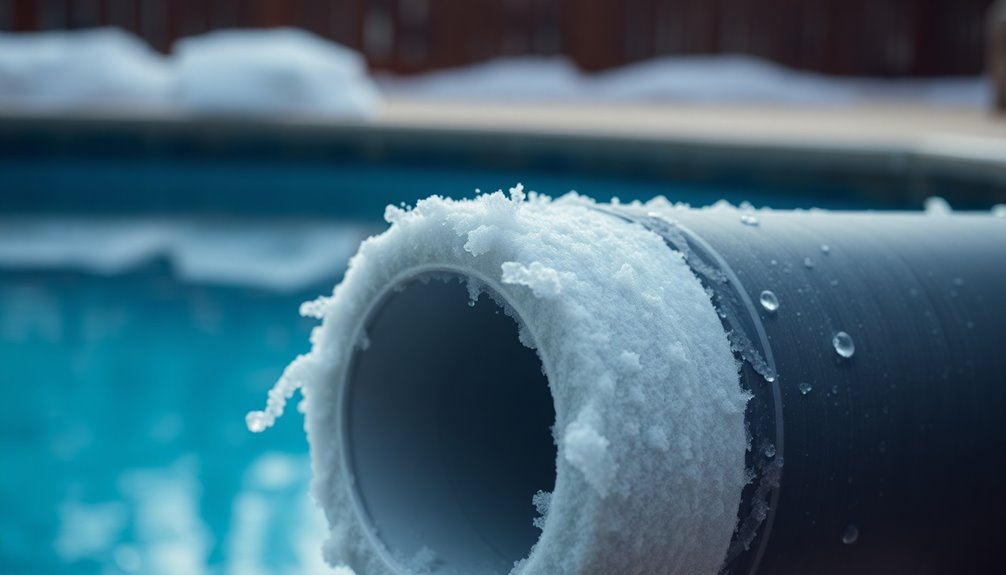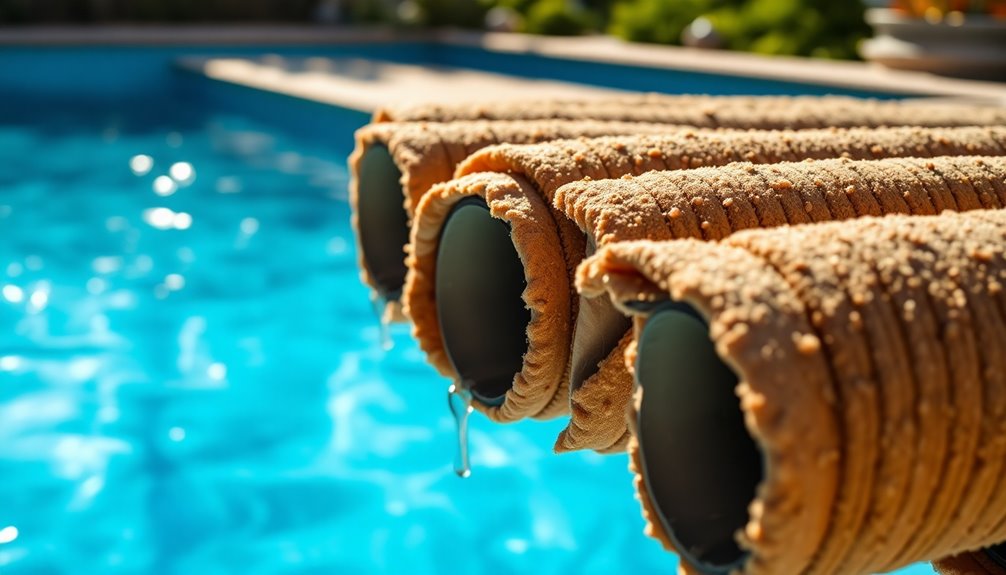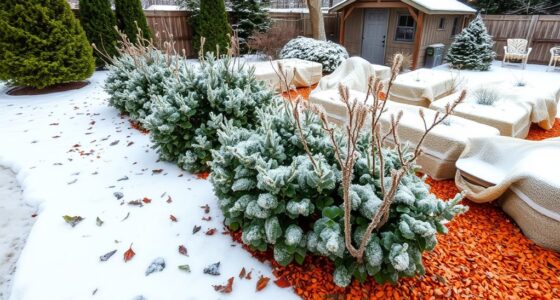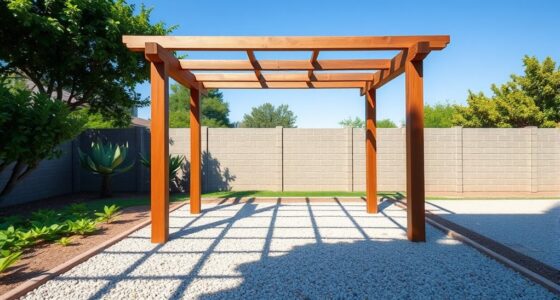If you want to keep your pool functional year-round, pool pipe insulation is essential. It considerably reduces heat loss, helping maintain warm water temperatures and improving energy efficiency, which lowers your utility bills. Insulating your pipes protects them from freezing and potential damage, especially vital for above-ground systems. Using materials like polystyrene foam sheets or polyethylene tubes guarantees a snug fit and lasts longer. Plus, this insulation minimizes condensation and noise. Regular maintenance checks can enhance performance, keeping your pool ready for use anytime. Explore the different insulation options and best practices to safeguard your investment and pool experience.
Key Takeaways
- Insulating pool pipes reduces heat loss, maintaining warmer water temperatures throughout the year and enhancing comfort.
- Utilize moisture-resistant materials like polyethylene foam tubes to protect pipes from freezing, preventing potential damage.
- Regular inspections and maintenance of insulation ensure optimal performance and longevity of the plumbing system.
- Implement winterization strategies, such as blowing out moisture and using antifreeze, to safeguard pipes during colder months.
- Monitor for leaks and insulate vulnerable areas to maintain system efficiency and avoid costly repairs.
Importance of Pool Pipe Insulation

When it comes to maintaining your pool, insulation for your pipes isn't just a luxury; it's essential.
Insulating your pool pipes reduces heat loss, keeping the water warmer for longer and improving energy efficiency. This means you won't need to crank up the heater as much, saving you money on utility bills. Additionally, above-ground pipes are more susceptible to heat loss, making insulation even more critical in these setups.
Plus, insulated pipes enhance system performance by ensuring hot water reaches your pool equipment without losing valuable heat. You'll enjoy consistent water temperatures, making your swimming experience more comfortable.
Insulation also protects your pipes from freezing in cold weather, preventing costly damage and extending their lifespan.
Ultimately, investing in pipe insulation leads to long-term savings and a more enjoyable pool experience year-round.
Types of Insulation Materials

To keep your pool running efficiently and comfortably, choosing the right insulation material for your pipes is key.
Polystyrene foam sheets are a popular, low-cost option that offers excellent thermal insulation with easy installation. Proper insulation selection can significantly enhance energy efficiency by reducing heat loss in pool systems.
If you need something with moisture resistance, consider polyethylene foam tubes, which fit snugly and are also inexpensive.
For high thermal efficiency, spray foam insulation is a great choice; it's durable and user-friendly for DIY projects.
Alternatively, polyurethane foam insulation provides exceptional thermal properties and moisture resistance, making it a cost-effective long-term solution.
Each of these materials has its strengths, so think about your specific needs when selecting the best insulation for your pool pipes.
Benefits of Insulating Pool Pipes

Insulating your pool pipes offers several key benefits that enhance efficiency and comfort.
First, it considerably reduces heat loss, helping you maintain water temperature while lowering your energy costs. You'll enjoy a more comfortable swimming experience year-round without wasting energy. Proper insulation also ensures that you select materials with the right thermal conductivity to maximize heat retention.
Additionally, insulation prevents condensation, protecting your pool system from moisture damage and ensuring its longevity.
You'll also have peace of mind knowing that insulated pipes help prevent freezing, reducing the risk of burst pipes and costly repairs.
Finally, insulation contributes to noise reduction and minimizes your environmental impact by conserving energy.
All these advantages make insulating your pool pipes a smart investment for both your wallet and your pool's functionality.
Installation Considerations

Proper installation of pool pipe insulation is just as important as the insulation itself. Start by identifying areas of heat loss, checking for gaps in the pool shell and pipework. Understanding your plumbing layout to pinpoint high-risk areas and inspect regularly, especially during seasonal changes, is crucial for maintaining efficiency. For materials, polystyrene foam sheets and polyethylene foam tubes are great options due to their effectiveness and ease of use. Guarantee tight fitting with no gaps or air pockets, and seal joints with silicone or caulk to prevent moisture infiltration. Additionally, implementing effective insulation can significantly reduce operational costs associated with pool heating. Regular maintenance of insulation can further enhance its performance and longevity. Consider additional protection measures like insulated pipe covers and reflective insulation for enhanced durability.
Maintenance and Regular Inspections

Maintaining your pool's pipe insulation is essential for preventing costly repairs and guaranteeing efficient operation. Start by monitoring for leaks using hydrostatic pressure testing and pressure gauges.
Regular inspections should include visual checks for cracks or sagging in the plumbing lines. Inspect for corrosion using methods like x-ray detection or ultrasonic thickness measurements to catch issues early. Additionally, ensure that your pipes are adequately protected with proper insulation to prevent freezing in extreme cold.
Ascertain proper insulation by covering crawl space vents with foam and sealing any gaps in the foundation. Prevent ice damage by utilizing an ice equalizer and regularly clearing snow from the pool cover.
Consistent checks and maintenance will keep your pool's plumbing system in top shape, allowing you to enjoy your pool year-round without unexpected problems.
Application Guidelines for Insulation

When it comes to protecting your pool's plumbing, selecting the right insulation material is essential for preventing heat loss and avoiding freeze damage.
Start with foam pipe insulation for easy installation, or heat tape if you're in extremely cold areas. Rubber insulation works well for durability under harsh conditions, while lightweight polyethylene is a solid choice for straightforward applications. To further enhance protection, make sure to drain pool pipes thoroughly before winterizing.
Be sure to inspect your pool plumbing layout to identify vulnerable areas, and address any gaps or leaks promptly. Proper installation is vital—ensure no gaps exist and seal joints with appropriate sealants.
Consider adding heat tracing or insulated pipe covers for extra protection against freezing temperatures. Follow these guidelines to keep your pool functioning year-round.
Energy Efficiency and Cost Savings

Insulating your pool's plumbing not only protects against heat loss but also leads to considerable energy efficiency and cost savings.
Proper insulation can reduce heat loss by up to 90%, keeping your pool water warmer for longer and cutting down on the need for additional heating. This means less energy is required, leading to lower fuel consumption and reduced energy bills—homeowners can save 10% to 20% on heating costs. By improving heat distribution, insulated pipes enhance overall system performance, making your heating system more efficient. Moreover, effective insulation lowers energy consumption, contributing to a smaller overall carbon footprint.
For businesses, these savings can greatly impact the bottom line, making insulation a smart investment for both residential and commercial settings.
Regular maintenance guarantees these benefits continue over time.
Protecting Against Freezing Risks

Proper insulation not only boosts energy efficiency but also shields your pool's plumbing from freezing risks during colder months.
To protect your pipes, start by draining the water completely and using an air compressor to blow out any remaining moisture. Check for leaks and insulate exposed pipes with foam or heat tape. Additionally, being aware of vulnerable plumbing areas can help you target specific spots that may need extra attention.
Running your pool pump occasionally keeps the water circulating, preventing freezing. Consider installing freeze protection devices like good-quality pool covers and adding pool-safe antifreeze when necessary.
Finally, seal off the system after applying antifreeze and monitor for leaks. By taking these steps, you'll guarantee your pool remains functional and safe throughout winter.
Frequently Asked Questions
How Often Should I Replace Pool Pipe Insulation?
You should replace pool pipe insulation every 10 to 30 years, depending on the material.
Foam insulation typically lasts 10-15 years, while fiberglass can last 20-30 years with proper care.
Regularly inspect the insulation every six months for signs of wear, like cracks or moisture buildup.
If you notice any damage or if it's nearing the end of its lifespan, consider replacing it to maintain your pool's efficiency and protect your equipment.
Can I Insulate Above-Ground Pool Pipes?
Yes, you can insulate above-ground pool pipes! Insulating these pipes helps maintain temperature and prevents freezing.
You've got several options, like foam insulation for easy installation or rubber insulation for maximum durability. Use cut-to-fit panels or wraps to guarantee a snug fit.
Just be sure to avoid moisture-absorbing materials that can diminish effectiveness. Proper insulation not only protects your pipes but also boosts energy efficiency and reduces maintenance needs.
What Are the Signs of Damaged Pipe Insulation?
You can spot signs of damaged pipe insulation by looking for visible frost, cracks, or leaks in the material.
Discoloration and loose wraps indicate problems too.
Pay attention to performance issues like decreased water flow, increased energy usage, and unusual gurgling noises.
Environmental factors, such as cold weather and poor ventilation, can worsen damage.
Finally, neglecting maintenance can lead to wear, moisture intrusion, and inadequate installation, all affecting your pipe insulation's effectiveness.
Is It Necessary to Insulate All Pool Pipes?
You might wonder if it's necessary to insulate all pool pipes.
While not every pipe needs insulation, doing so for those exposed to temperature extremes can prevent heat loss and reduce energy costs.
Insulating helps maintain consistent water temperatures and protects pipes from condensation damage.
It's a smart move to focus on areas most vulnerable to cold weather or heat loss, ensuring your pool remains functional and efficient throughout the year.
Can I Install Insulation Myself, or Hire a Professional?
You can definitely install insulation yourself, but it depends on your skill level and comfort with the process.
DIY insulation can save you money and give you immediate results, but it can also be time-consuming and complex.
Hiring a professional guarantees quality installation and prevents costly mistakes, though it may be more expensive.
Weigh your expertise, budget, and the project's complexity to decide which option suits you best.
Conclusion
To summarize, insulating your pool pipes is essential for maintaining their functionality throughout the year. By choosing the right materials and ensuring proper installation, you'll protect your investment from freezing risks and reduce energy costs. Regular maintenance and inspections will keep everything in top shape, allowing you to enjoy your pool hassle-free. So, don't wait—take the necessary steps to insulate your pipes and experience the benefits firsthand. Your pool deserves it!









